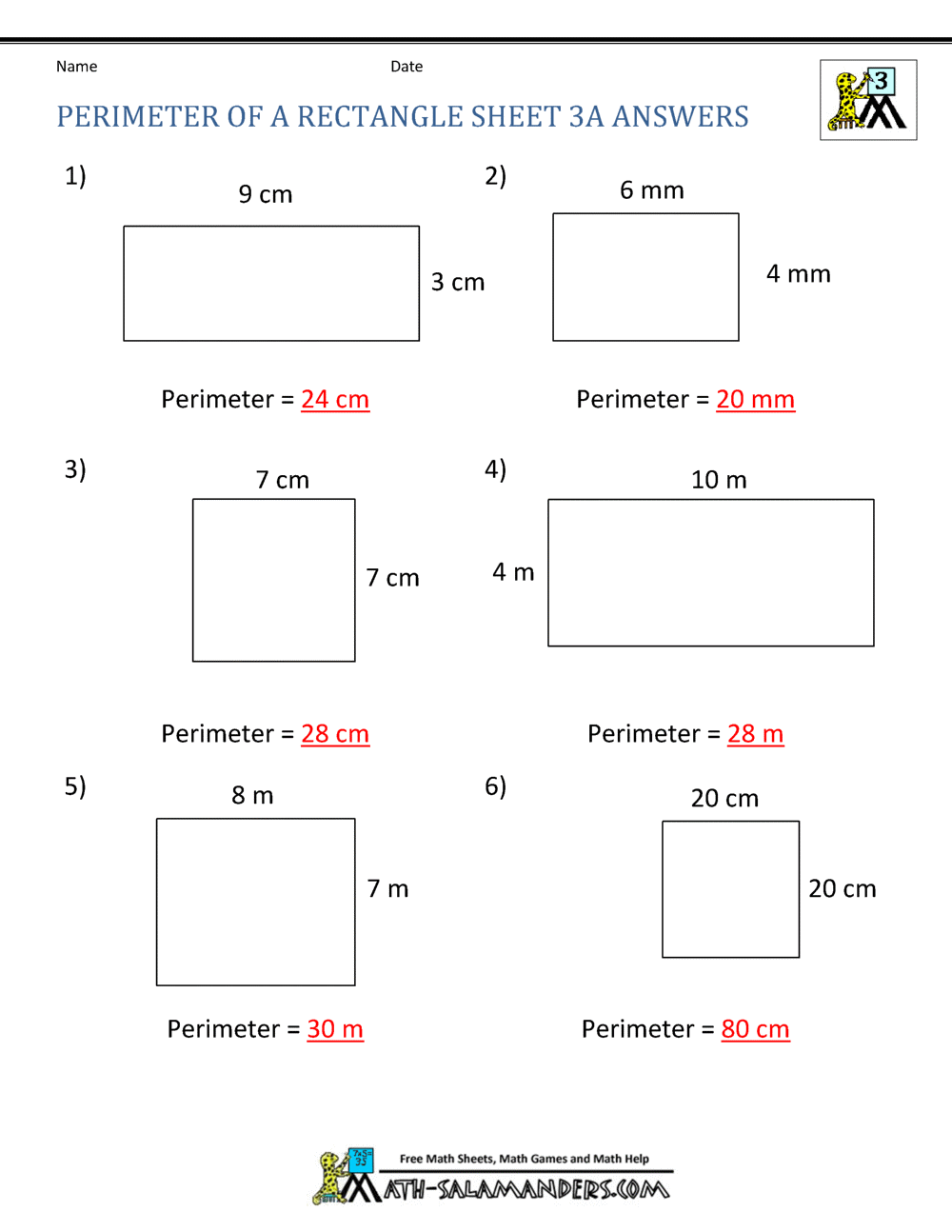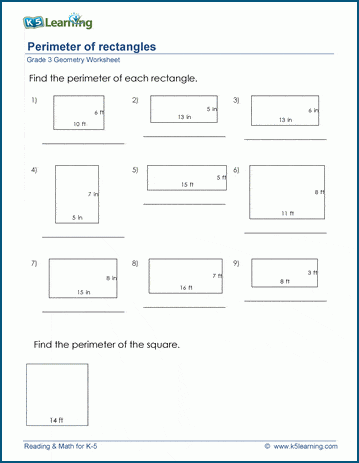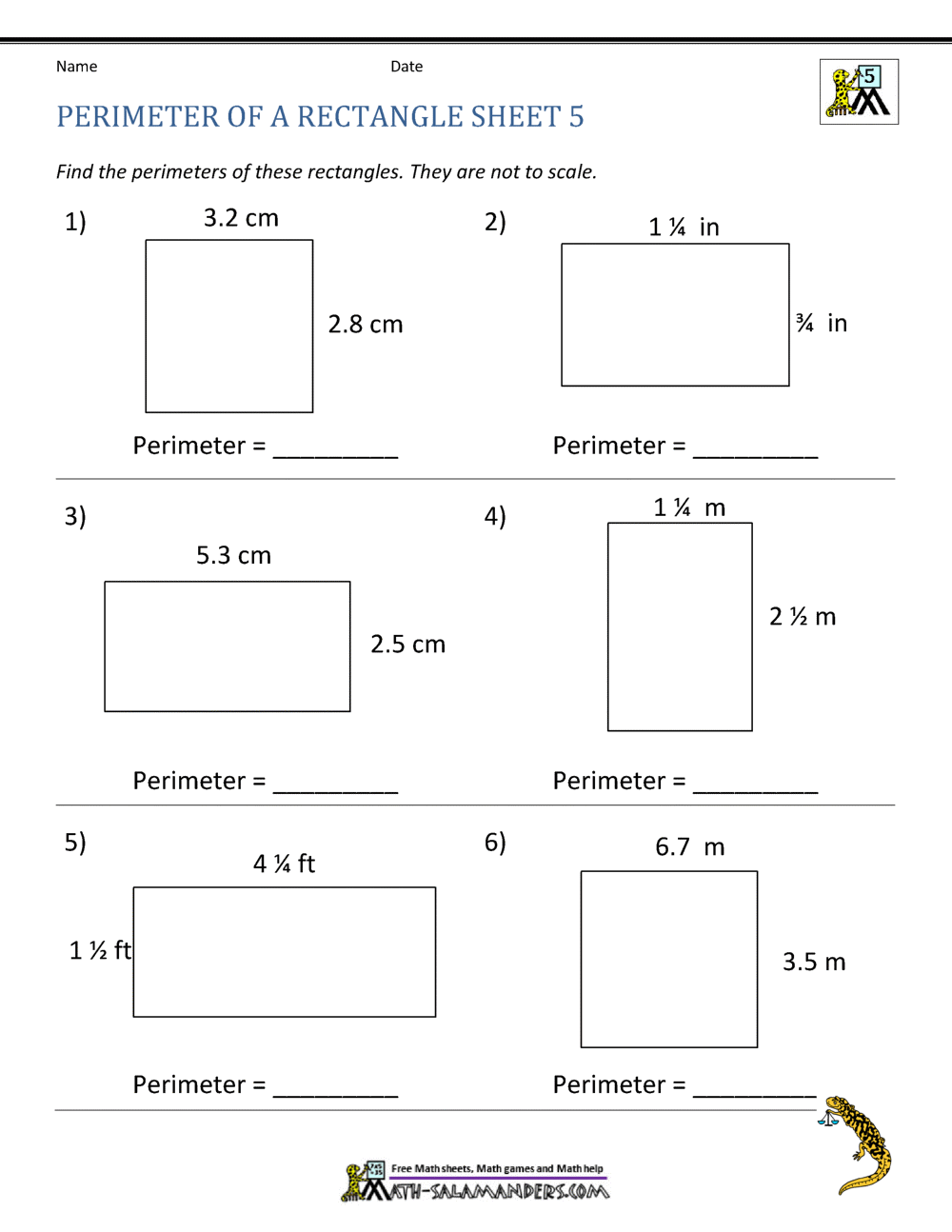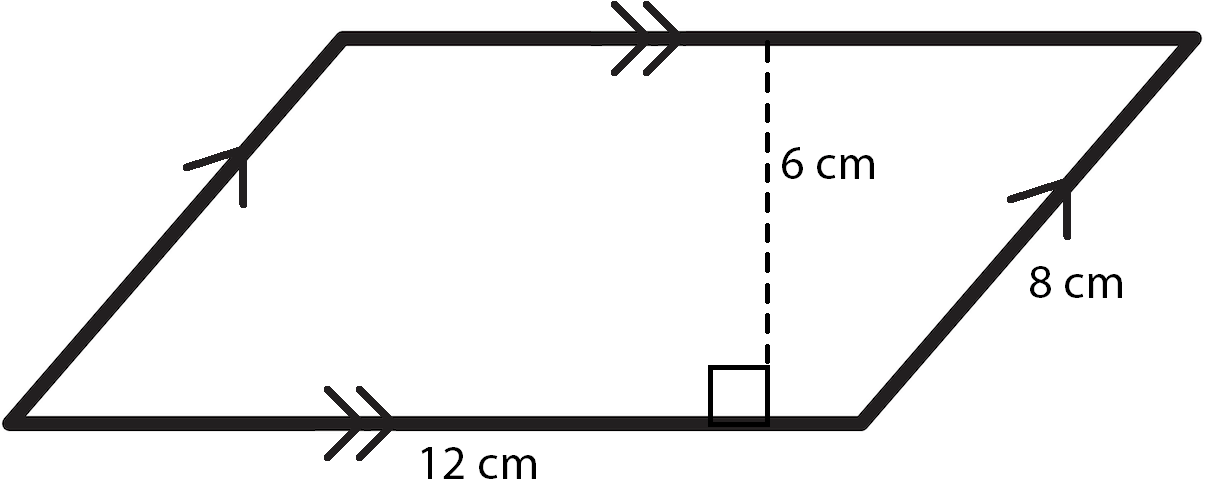Topic perimeter of a rectangle worksheet: Discover everything you need to know about the perimeter of a rectangle with our comprehensive worksheet guide. Learn the formula, step-by-step calculations, and explore real-life applications. Enhance your understanding through interactive exercises and avoid common mistakes. Perfect for students looking to master perimeter calculations and excel in their studies.
Table of Content
- Perimeter of a Rectangle Worksheet
- Introduction to Perimeter of a Rectangle
- Understanding the Perimeter Formula
- Step-by-Step Calculation of Rectangle Perimeter
- Examples of Calculating Perimeter
- Practice Problems and Exercises
- Real-Life Applications of Rectangle Perimeter
- Common Mistakes to Avoid
- Interactive Perimeter Worksheets
- Answer Keys and Explanations
- Additional Resources for Further Learning
- Conclusion and Summary
- YOUTUBE: Hướng dẫn chi tiết cách tìm chu vi hình chữ nhật với Thầy J. Video này sẽ giúp bạn hiểu rõ hơn về cách tính chu vi và áp dụng vào các bài tập thực tế.
Perimeter of a Rectangle Worksheet
Understanding the perimeter of a rectangle is essential for students learning geometry. This worksheet is designed to help students practice and master the concept of finding the perimeter of rectangles.
Introduction
The perimeter of a rectangle is the total distance around the outside of the rectangle. It can be calculated using the formula:
\[ P = 2(l + w) \]
where \(P\) is the perimeter, \(l\) is the length, and \(w\) is the width of the rectangle.
Examples
Here are some examples to illustrate how to calculate the perimeter of a rectangle:
-
Example 1: Find the perimeter of a rectangle with a length of 8 cm and a width of 5 cm.
\[ P = 2(8\, \text{cm} + 5\, \text{cm}) = 2(13\, \text{cm}) = 26\, \text{cm} \]
-
Example 2: Find the perimeter of a rectangle with a length of 10 m and a width of 4 m.
\[ P = 2(10\, \text{m} + 4\, \text{m}) = 2(14\, \text{m}) = 28\, \text{m} \]
Practice Problems
Solve the following problems to practice finding the perimeter of rectangles:
- Find the perimeter of a rectangle with a length of 12 cm and a width of 7 cm.
- Find the perimeter of a rectangle with a length of 15 m and a width of 6 m.
- Find the perimeter of a rectangle with a length of 9 cm and a width of 4 cm.
- Find the perimeter of a rectangle with a length of 20 m and a width of 10 m.
Worksheet
Complete the following table by calculating the perimeter for each given rectangle:
| Length (l) | Width (w) | Perimeter (P) |
|---|---|---|
| 8 cm | 5 cm | \[ P = 2(8\, \text{cm} + 5\, \text{cm}) \] |
| 10 m | 4 m | \[ P = 2(10\, \text{m} + 4\, \text{m}) \] |
| 7 cm | 3 cm | \[ P = 2(7\, \text{cm} + 3\, \text{cm}) \] |
| 9 m | 5 m | \[ P = 2(9\, \text{m} + 5\, \text{m}) \] |
Conclusion
Practicing with these worksheets will help students become confident in calculating the perimeter of rectangles. Ensure to check your answers and understand each step in the calculation process.

READ MORE:
Introduction to Perimeter of a Rectangle
The perimeter of a rectangle is a fundamental concept in geometry that measures the total distance around the rectangle. Understanding how to calculate the perimeter is essential for various real-world applications and mathematical problems. The formula for the perimeter of a rectangle is:
$$ P = 2l + 2w $$
where:
- \( P \) represents the perimeter
- \( l \) is the length of the rectangle
- \( w \) is the width of the rectangle
To find the perimeter of a rectangle, you need to know the length and width of the rectangle. Follow these steps:
- Measure the length (\( l \)) of the rectangle.
- Measure the width (\( w \)) of the rectangle.
- Apply the formula: \( P = 2l + 2w \).
- Add the values: First, double the length and the width, then sum them up.
For example, if a rectangle has a length of 8 units and a width of 5 units, the perimeter is calculated as follows:
| Step | Calculation | Result |
| Double the length | 2 × 8 | 16 |
| Double the width | 2 × 5 | 10 |
| Sum the results | 16 + 10 | 26 |
Therefore, the perimeter of the rectangle is 26 units. Understanding this concept will help you tackle more complex geometric problems and apply it in practical situations.
Understanding the Perimeter Formula
The perimeter formula for a rectangle is a simple yet essential part of geometry. It helps in determining the distance around a rectangle, which is useful in various mathematical and real-world contexts. The formula for the perimeter (\( P \)) of a rectangle is expressed as:
$$ P = 2(l + w) $$
where:
- \( P \) is the perimeter of the rectangle.
- \( l \) represents the length of the rectangle.
- \( w \) represents the width of the rectangle.
Let's break down how this formula works:
- Identify the Length and Width: Measure the length (\( l \)) and width (\( w \)) of the rectangle. These measurements are usually given in the same units, such as meters, feet, or inches.
- Sum the Length and Width: Add the length and width together. This sum gives you the total measurement of one length and one width of the rectangle.
- Double the Sum: Multiply the sum of the length and width by 2. This accounts for both pairs of opposite sides in the rectangle.
For example, if a rectangle has a length of 10 units and a width of 4 units, you can find the perimeter as follows:
| Step | Calculation | Result |
| Sum the length and width | 10 + 4 | 14 |
| Double the sum | 2 × 14 | 28 |
Thus, the perimeter of the rectangle is 28 units.
This formula provides a straightforward method to calculate the perimeter of any rectangle, ensuring you can accurately measure the distance around these shapes in various contexts.
Step-by-Step Calculation of Rectangle Perimeter
Calculating the perimeter of a rectangle is a straightforward process that involves a few simple steps. Here is a detailed, step-by-step guide to help you find the perimeter of any rectangle:
- Measure the Length and Width: Use a ruler or measuring tape to determine the length (\( l \)) and width (\( w \)) of the rectangle. Ensure both measurements are in the same units.
- Apply the Perimeter Formula: Use the formula for the perimeter of a rectangle:
$$ P = 2(l + w) $$
- Sum the Length and Width: Add the length and width of the rectangle.
\( l + w \)
- Double the Sum: Multiply the result by 2 to get the total perimeter.
\( P = 2(l + w) \)
Let's work through an example to illustrate these steps:
| Step | Calculation | Result |
| 1. Measure the length and width | Length (\( l \)) = 12 units Width (\( w \)) = 5 units |
|
| 2. Sum the length and width | 12 + 5 | 17 |
| 3. Double the sum | 2 × 17 | 34 |
Therefore, the perimeter of the rectangle is 34 units.
By following these steps, you can easily calculate the perimeter of any rectangle, ensuring accuracy in your geometric calculations.
Examples of Calculating Perimeter
Understanding the perimeter calculation is best achieved through practical examples. Below are several examples that illustrate how to calculate the perimeter of a rectangle using different sets of dimensions.
Example 1:
Consider a rectangle with a length of 8 units and a width of 3 units.
- Identify the dimensions: Length (\( l \)) = 8 units, Width (\( w \)) = 3 units
- Apply the perimeter formula:
$$ P = 2(l + w) $$
- Calculate the sum of the length and width:
8 + 3 = 11
- Double the sum:
2 \times 11 = 22
The perimeter of the rectangle is 22 units.
Example 2:
Consider a rectangle with a length of 15 units and a width of 10 units.
- Identify the dimensions: Length (\( l \)) = 15 units, Width (\( w \)) = 10 units
- Apply the perimeter formula:
$$ P = 2(l + w) $$
- Calculate the sum of the length and width:
15 + 10 = 25
- Double the sum:
2 \times 25 = 50
The perimeter of the rectangle is 50 units.
Example 3:
Consider a rectangle with a length of 7.5 units and a width of 4.2 units.
- Identify the dimensions: Length (\( l \)) = 7.5 units, Width (\( w \)) = 4.2 units
- Apply the perimeter formula:
$$ P = 2(l + w) $$
- Calculate the sum of the length and width:
7.5 + 4.2 = 11.7
- Double the sum:
2 \times 11.7 = 23.4
The perimeter of the rectangle is 23.4 units.
These examples demonstrate the straightforward nature of calculating the perimeter of a rectangle. By following the steps outlined, you can easily determine the perimeter for any set of dimensions.

Practice Problems and Exercises
To solidify your understanding of how to calculate the perimeter of a rectangle, here are some practice problems and exercises. Work through each problem step-by-step, applying the perimeter formula:
$$ P = 2(l + w) $$
Practice Problem 1
Calculate the perimeter of a rectangle with a length of 9 units and a width of 4 units.
- Identify the dimensions: Length (\( l \)) = 9 units, Width (\( w \)) = 4 units
- Apply the formula:
$$ P = 2(9 + 4) $$
- Calculate the sum:
9 + 4 = 13
- Double the sum:
2 \times 13 = 26
The perimeter is 26 units.
Practice Problem 2
Calculate the perimeter of a rectangle with a length of 14.5 units and a width of 6.3 units.
- Identify the dimensions: Length (\( l \)) = 14.5 units, Width (\( w \)) = 6.3 units
- Apply the formula:
$$ P = 2(14.5 + 6.3) $$
- Calculate the sum:
14.5 + 6.3 = 20.8
- Double the sum:
2 \times 20.8 = 41.6
The perimeter is 41.6 units.
Practice Problem 3
Calculate the perimeter of a rectangle with a length of 11 units and a width of 7 units.
- Identify the dimensions: Length (\( l \)) = 11 units, Width (\( w \)) = 7 units
- Apply the formula:
$$ P = 2(11 + 7) $$
- Calculate the sum:
11 + 7 = 18
- Double the sum:
2 \times 18 = 36
The perimeter is 36 units.
Exercises
Try solving the following problems on your own:
- 1. A rectangle has a length of 20 units and a width of 8 units. What is its perimeter?
- 2. Find the perimeter of a rectangle with a length of 7.2 units and a width of 3.8 units.
- 3. A rectangle's length is 15 units and its width is 9 units. Calculate its perimeter.
- 4. Determine the perimeter of a rectangle with a length of 12.5 units and a width of 5.5 units.
By practicing these problems, you'll enhance your ability to quickly and accurately determine the perimeter of any rectangle.
Real-Life Applications of Rectangle Perimeter
Understanding the perimeter of a rectangle has numerous real-life applications. Here are some common scenarios where calculating the perimeter is essential:
1. Fencing a Yard
When planning to fence a rectangular yard, knowing the perimeter helps determine the amount of fencing material needed.
- Measure the length and width of the yard.
- Apply the perimeter formula:
$$ P = 2(l + w) $$
- Calculate the total fencing required based on the perimeter.
2. Framing a Picture
To frame a rectangular picture, the perimeter calculation helps in determining the length of the frame material needed.
- Measure the length and width of the picture.
- Use the perimeter formula:
$$ P = 2(l + w) $$
- Calculate the frame material required by the perimeter.
3. Laying Out a Garden
When designing a rectangular garden bed, the perimeter helps in planning the boundary and the materials needed for edging.
- Determine the length and width of the garden bed.
- Apply the perimeter formula:
$$ P = 2(l + w) $$
- Use the calculated perimeter to purchase edging materials.
4. Carpet Installation
For installing a carpet in a rectangular room, knowing the perimeter can help in ensuring proper fitting and estimating additional border materials.
- Measure the length and width of the room.
- Apply the perimeter formula:
$$ P = 2(l + w) $$
- Ensure the carpet fits well within the perimeter and consider border materials if needed.
5. Building Construction
In construction, perimeter calculations are used for laying foundations and planning walls for rectangular buildings.
- Measure the length and width of the building plot or foundation.
- Apply the perimeter formula:
$$ P = 2(l + w) $$
- Use the perimeter to estimate materials needed for foundations and walls.
By understanding how to calculate the perimeter of a rectangle, you can efficiently tackle various practical tasks and projects, ensuring accuracy and efficiency in planning and execution.
Common Mistakes to Avoid
While calculating the perimeter of a rectangle is straightforward, there are common mistakes that students often make. Here are some tips to help you avoid these errors:
1. Mixing Up Length and Width
It's important to correctly identify the length and width of the rectangle. Ensure you measure and label each dimension accurately.
- Verify the measurements of the length (\( l \)) and width (\( w \)).
- Double-check the labels to avoid confusion.
2. Incorrectly Applying the Formula
Make sure to use the correct formula for the perimeter:
$$ P = 2(l + w) $$
- Write down the formula before substituting the values.
- Ensure you add the length and width first, then multiply by 2.
3. Unit Conversion Errors
Always use consistent units for length and width. Converting units incorrectly can lead to inaccurate results.
- Ensure both dimensions are in the same unit (e.g., meters, feet).
- Convert units if necessary before applying the formula.
4. Calculation Mistakes
Errors in basic arithmetic can lead to incorrect perimeter values. Double-check your calculations to avoid mistakes.
- Use a calculator for accuracy.
- Review each step of your calculation process.
5. Forgetting to Double the Sum
A common mistake is forgetting to multiply the sum of the length and width by 2.
- Remember the formula requires doubling the sum:
$$ P = 2(l + w) $$
- Check that you have included the multiplication step.
Example of a Correct Calculation
Consider a rectangle with a length of 7 units and a width of 5 units:
- Identify the dimensions: Length (\( l \)) = 7 units, Width (\( w \)) = 5 units
- Apply the formula:
$$ P = 2(7 + 5) $$
- Calculate the sum:
7 + 5 = 12
- Double the sum:
2 \times 12 = 24
The correct perimeter is 24 units.
By being mindful of these common mistakes and following the steps carefully, you can ensure accurate perimeter calculations for any rectangle.
Interactive Perimeter Worksheets
Interactive perimeter worksheets are an excellent way to practice and reinforce your understanding of calculating the perimeter of a rectangle. These worksheets provide a hands-on approach to learning and offer immediate feedback. Here's a step-by-step guide to using interactive worksheets effectively:
1. Accessing the Worksheets
Find online platforms that offer interactive perimeter worksheets. Many educational websites provide free resources that can be accessed easily.
- Search for "interactive perimeter of a rectangle worksheets" on your preferred search engine.
- Select a reputable educational website that offers these resources.
2. Understanding the Worksheet Layout
Interactive worksheets typically have a user-friendly interface with clear instructions. Familiarize yourself with the layout:
- Read the instructions carefully.
- Identify the input fields where you need to enter the length and width of the rectangle.
- Locate the 'Calculate' or 'Submit' button to process your inputs.
3. Entering Data
Follow these steps to enter the dimensions of the rectangle and calculate its perimeter:
- Measure the length and width of the rectangle or use the given values in the worksheet.
- Enter the length (\( l \)) and width (\( w \)) into the respective input fields.
- Click the 'Calculate' or 'Submit' button to view the result.
4. Reviewing Results
After submitting your inputs, the worksheet will display the calculated perimeter along with a step-by-step solution:
- Verify the accuracy of the entered dimensions.
- Check the calculated perimeter to ensure it matches your manual calculation.
- Review the step-by-step solution to understand the process.
5. Practicing Multiple Problems
Practice with multiple problems to enhance your skills:
- Work on different sets of length and width values.
- Attempt varying levels of difficulty to challenge yourself.
- Use the feedback provided to improve your accuracy.
6. Tracking Progress
Many interactive worksheets allow you to track your progress over time:
- Record your scores and improvement in a notebook.
- Identify areas where you need more practice.
- Set goals for improving your calculation speed and accuracy.
Benefits of Interactive Worksheets
Using interactive worksheets offers several advantages:
- Immediate feedback helps in correcting mistakes promptly.
- Engaging and interactive interface makes learning fun.
- Variety of problems ensures comprehensive practice.
- Tracking progress helps in identifying strengths and areas for improvement.
Incorporating interactive perimeter worksheets into your study routine can greatly enhance your understanding and proficiency in calculating the perimeter of rectangles. Start using these resources today to master this essential math skill!

Answer Keys and Explanations
Answer keys and explanations are crucial for verifying your solutions and understanding the steps involved in calculating the perimeter of a rectangle. Here, we provide detailed explanations for some sample problems:
Sample Problem 1
Question: Calculate the perimeter of a rectangle with a length of 8 units and a width of 3 units.
- Identify the dimensions: Length (\( l \)) = 8 units, Width (\( w \)) = 3 units
- Apply the formula:
$$ P = 2(l + w) $$
- Substitute the values:
$$ P = 2(8 + 3) $$
- Calculate the sum:
8 + 3 = 11
- Double the sum:
2 \times 11 = 22
Answer: The perimeter is 22 units.
Sample Problem 2
Question: Calculate the perimeter of a rectangle with a length of 5.5 units and a width of 2.5 units.
- Identify the dimensions: Length (\( l \)) = 5.5 units, Width (\( w \)) = 2.5 units
- Apply the formula:
$$ P = 2(l + w) $$
- Substitute the values:
$$ P = 2(5.5 + 2.5) $$
- Calculate the sum:
5.5 + 2.5 = 8
- Double the sum:
2 \times 8 = 16
Answer: The perimeter is 16 units.
Sample Problem 3
Question: Calculate the perimeter of a rectangle with a length of 12 units and a width of 7 units.
- Identify the dimensions: Length (\( l \)) = 12 units, Width (\( w \)) = 7 units
- Apply the formula:
$$ P = 2(l + w) $$
- Substitute the values:
$$ P = 2(12 + 7) $$
- Calculate the sum:
12 + 7 = 19
- Double the sum:
2 \times 19 = 38
Answer: The perimeter is 38 units.
Common Errors and Clarifications
Here are some common mistakes and how to avoid them:
- Incorrect Addition: Ensure that the addition of length and width is accurate before doubling the sum.
- Mislabeling Dimensions: Double-check that you correctly identify and label the length and width.
- Unit Consistency: Ensure all dimensions are in the same units before performing calculations.
By carefully following the steps and reviewing the explanations, you can confidently calculate the perimeter of any rectangle and verify your answers accurately.
Additional Resources for Further Learning
To deepen your understanding and enhance your skills in calculating the perimeter of a rectangle, the following resources provide a wealth of information and practice opportunities:
- Online Practice and Interactive Tools:
- : A comprehensive collection of perimeter worksheets, including exercises involving customary units, decimals, and unit conversions.
- : Interactive lessons and word problems to help you practice and understand the perimeter of rectangles.
- : Worksheets for different grade levels, covering perimeter calculations with integers, decimals, and fractions.
- Video Tutorials:
- : Video tutorials explaining how to calculate the area and perimeter of rectangles and other shapes.
- : A variety of instructional videos on calculating the perimeter of a rectangle.
- Printable Worksheets and Activities:
- : Generate customizable printable worksheets for practicing the perimeter of rectangles.
- : Printable worksheets designed for different grade levels to help students master the concept of perimeter.
- Comprehensive Learning Platforms:
- : Offers a wide range of exercises and personalized learning plans for students to practice perimeter calculations.
- : Provides interactive and printable worksheets along with detailed explanations for solving perimeter problems.
- Fun and Games:
- : Interactive games and activities to make learning about perimeter fun and engaging.
- : Engaging games and quizzes focused on finding the perimeter of various shapes, including rectangles.
These resources offer a mix of explanations, practice problems, and interactive learning opportunities to help you master the concept of perimeter for rectangles. Explore these tools to find the ones that best suit your learning style and needs.
Conclusion and Summary
Understanding the perimeter of a rectangle is essential for solving various mathematical and real-life problems. This comprehensive guide has provided you with a detailed approach to mastering the concept.
- The perimeter of a rectangle is the total distance around the outside of the rectangle. It is calculated using the formula: \( P = 2(l + w) \), where \( l \) is the length and \( w \) is the width.
- We have explored the step-by-step calculation process, starting from understanding the basic dimensions of a rectangle to applying the perimeter formula.
- Through various examples, we demonstrated how to accurately calculate the perimeter in different scenarios.
- The practice problems and exercises provided help reinforce your understanding and ensure you can apply the formula correctly.
- Real-life applications of calculating the perimeter of a rectangle show how this knowledge can be applied in fields such as construction, design, and everyday situations.
- We highlighted common mistakes to avoid, ensuring you can approach perimeter calculations with confidence.
- The interactive worksheets offer a hands-on approach to learning, making the process engaging and effective.
- Answer keys and explanations ensure you can verify your work and understand any errors.
- We have also provided additional resources for further learning, allowing you to deepen your understanding and explore more complex concepts.
By following this guide, you have gained a thorough understanding of the perimeter of a rectangle. Remember, practice and application are key to mastering this concept. Keep working through problems, and you'll find that calculating the perimeter of a rectangle becomes second nature.
We hope this guide has been helpful and informative. Keep exploring and learning!
Hướng dẫn chi tiết cách tìm chu vi hình chữ nhật với Thầy J. Video này sẽ giúp bạn hiểu rõ hơn về cách tính chu vi và áp dụng vào các bài tập thực tế.
Cách Tìm Chu Vi Hình Chữ Nhật | Toán với Thầy J
READ MORE:
Hướng dẫn cách tìm diện tích và chu vi hình chữ nhật một cách chi tiết và dễ hiểu. Video này sẽ giúp bạn nắm vững các khái niệm và áp dụng vào bài tập thực tế.
Cách Tìm Diện Tích và Chu Vi Hình Chữ Nhật













